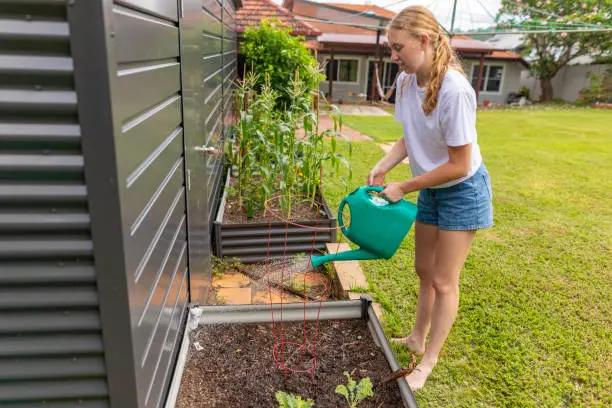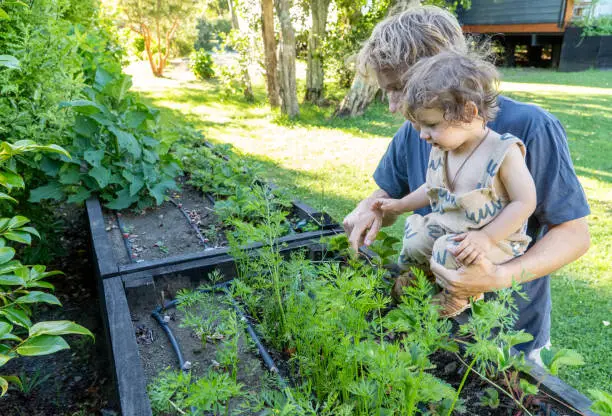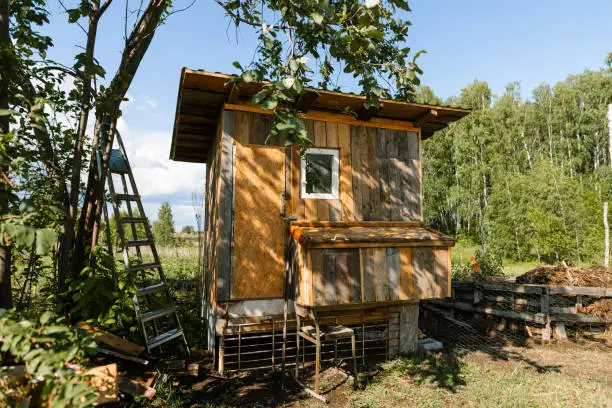Have you pondered if your garden is more than a lovely face? Enter the secret world of beneficial insects. The hidden heroes of backyard homesteading may create a vibrant ecology.
Ladybugs first. These adorable spotted beauties devour aphids. One ladybug can eat 50 aphids daily! Imagine tiny, armored knights protecting your plants from intruders. High-five one mentally the next time you see one.
Buzz over to bees. Mason bees, specifically. Mason bees are solitary and don’t sting unless provoked. They pollinate well despite being introverted bees. A few mason bees may pollinate flowers and vegetables like hundreds of honeybees.
Green warriors called praying mantises are your garden’s best bodyguards despite their strange appearance. They devour flies, beetles, and even other praying mantises! Imagine tiny velociraptors guarding your plants.
Remember ground beetles. These nighttime hunters enjoy eating slugs and caterpillars that might damage your crops. Consider them your garden’s night shift security.
Do not be deceived by hoverflies’ little bee or wasp-like appearance. Their larvae kill aphids, and adults pollinate. Like receiving two benefits for one!
Tachinid flies—heard of them? Although not well-known, these flies lay their eggs on caterpillars and beetles. When eggs hatch, they eat their hosts internally. Gross? Yes. Effective? Absolutely.

Lacewings have delicate wings and vicious larvae called “aphid lions.” These little fellas eat aphids faster than “organic pest control.”
Who forgets spiders? Many people dislike spiders, but they manage garden bug populations. Nature’s pest control service works 24/7 for free.
Ants are stereotyped as pests that ruin picnics and homes; however, some species benefit from gardening! They feed on termites and fleas and aerate the soil.
Nematodes—soil-dwelling worms that kill root-damaging grubs before they become plant-eaters—should also be considered.
Attracting these beneficial insects requires building an enticing environment—like a bug motel! Different insects eat and lay eggs on other plants, so cultivate a variety.
Marigolds attract lacewings, dill hoverflies, and ladybugs enjoy dandelions. Some weeds can be host plants or nectar sources for these beneficial insects if allowed to flourish.
Add water sources or insect motels fashioned from bundles of sticks or bamboo tubes to let solitary bees nest away from predators and curious neighbors.
My grandpa taught me to keep piles of leaves around in the fall to protect ground beetles during winter so they’re ready for pests in spring!
If you’re crafty or bored, Mason bees hunting for pollination sites can live in simple shelters made from old logs with holes!
Remember that not all bugs are beneficial, so know the difference before inviting them into your garden paradise!
By attracting beneficial insects to our gardens, we benefit ourselves and aid worldwide biodiversity conservation efforts.
Next time someone calls you crazy because you have more bugs than bloom, remember that what you’re doing makes Mother Nature proud!
Organic Backyard Garden Pest Control: Nature’s Way to a Healthy Homestead
Backyard homesteading is fun. Nothing beats eating a homegrown tomato or fresh herbs for dinner. Then pests appear. Those tiny invaders can make your yard a war zone. How do you fight back without hazardous chemicals? Learn about organic treatments and methods to help your garden thrive.

Garlic Spray is a vampire repellent.
We’re not talking about preventing Dracula. Garlic spray repels aphids, caterpillars, and beetles. How to make it:
1. Crush 10-12 garlic cloves.
2. Mix with one qt water.
3. Wait overnight.
4. Pour into spray bottle after straining.
Spray this mixture on plants every few days. It repels bugs and makes you feel like a magician creating potions!
Neem Oil: Multipurpose Warrior
Neem oil is the Swiss Army knife of organic pest control. It repels mites, aphids, whiteflies, and more! Add two teaspoons of neem oil and one teaspoon of mild liquid soap to a quart of water. Shake thoroughly, then spray the damaged plants directly.
Once, spider mites on my cucumber plants wove webs like they were auditioning for “Charlotte’s Web.” Mites disappeared after a few neem oil treatments.
Diatomaceous Earth: Fossilized Fury
This fossilized algae powder repels slugs, bugs, and other crawlers. Sprinkle it around plant bases or pest-prone foliage.
Wet diatomaceous earth loses potency faster than ice cream melts on a hot day, so reapply after rain.
Simple yet Effective Soap Spray
Sometimes, the most straightforward answers work best. Aphid and mealybug cell membranes can be disrupted by soap spray.
1. Add one tablespoon of mild liquid soap to one quart of water.
2. Pour into a spray bottle.
3. Put directly on affected regions.
My neighbor believes this procedure works as well as evicting the pests!
Natural Bodyguards: Companion Planting
Why fight alone when you can join forces? Companion planting involves growing plants together to repel pests or attract beneficial insects.
For instance:
Marigolds repel nematodes.
Basil controls mosquitoes and flies and boosts tomato development.
Aphids love nasturtiums over virtually anything else, making them sacrifice plants!
Companion planting is like having garden bodyguards who are also party guests.
Turn Up the Heat with Chili Pepper Spray
Some pests hate spicy food as much as humans! Making chili pepper spray:
1. Blend two handfuls of fresh chili peppers with one cup of water until smooth.
Use cheesecloth to strain.
3. Pour another quart of water and a few dish soap drops.
Spray this flaming concoction on insect-infested plants—avoid getting it in your eyes!
Beer Traps: Slug Happy Hour
Slugs love beer almost as much as humans (who knew?). Overnight, bury shallow beer containers with their rims level with the soil in your garden. Slugs will crawl in but not out.
Setting up slug tiny pubs with an early last call is like that!
Essential Oils: Aromatic Defense
Peppermint, eucalyptus, and rosemary essential oils repel ants and mosquitoes:
1. Add 10-15 drops per oil type to two cups water and 1/2 teaspoon dish soap.
2. Shake thoroughly before spraying problematic areas or around doorways/windows if indoor pests are common in summer!
I had ants in my kitchen continuously until I started using peppermint oil combined with the above. They couldn’t handle the intense aroma and moved outside, leaving us ant-free again.
Finally, these natural solutions should help maintain healthy gardens without harming the environment, family, pets, etc. Good gardening, enjoy fruits, and work!





Leave a Reply
You must be logged in to post a comment.